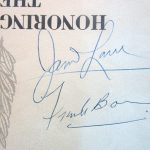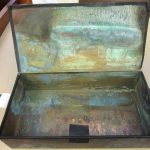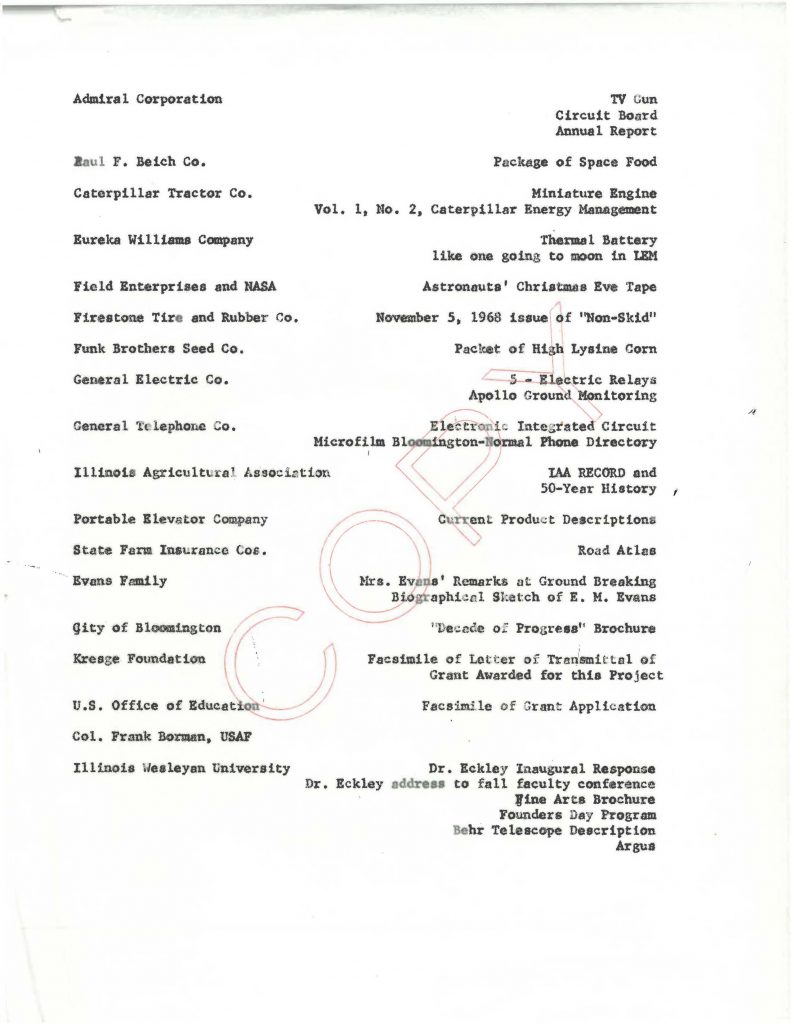Although many more are known to exist, only three time capsules have been opened in IWU’s 169-year history. One was discovered accidentally when the iconic arch that still led into Duration Hall, last remnant of Hedding Hall/Old Main, was torn down. All that remains of the contents of that box are pieces of bank notes it contained and the description of its other contents as reported in the 1966 Wesleyana (p. 23).
The second was a much more purposeful removal from Sheean Library.The contents of this box were in excellent condition and are reported on in previous blog posts. The third was also a planned removal, this time in honor of the 50th anniversary of its placement rather than being due to the building’s destruction. This post describes the discoveries made as a result of this recent unveiling.
As previously reported, when the Evans Observatory’s time capsule was opened in preparation for the official unveiling at Homecoming 2019, much of the content was too deteriorated to salvage. Moisture interacted with a battery and food inside the copper box and the damage to the other material was extensive!

A poster of several of the damaged objects (clockwise from top right): the thermal battery, a microfilm reel with the Bloomington phone directory (rolled and unrolled), close-up of a rolled map (enclosed in a plastic sleeve and closed by a metal snap; unrolled map in center), a long shot of the capsule’s damaged contents. (click any image in this blog post to enlarge)
Everything that was paper-based was congealed into a solid mass but fortunately, most of these were all widely distributed publications from the University and local businesses. We were able to separate two unique paper items:
- Remarks by Mrs. Nan Evans
- The Beich Co. survival rations described in this blog’s Nov. 19, 2019 post.
Several unique objects survived their 50-year odyssey and one even went on the Apollo 8 mission, circling the moon ten times! Astronaut Frank Borman personally added the medallion picture below before placing the capsule in the Mark Evans Observatory.
- The Apollo 8 mission’s flight path is depicted in relief on the front of the medallion.
- The names of the three astronauts, mission name and date span are in raised letters.
- IWU alumnus David W. Wilson ’70 had Borman sign his 1969 program on that Founders’ Day. Lovell signed it during a campus visit in 1988. Wilson donated the program during the 2019 Homecoming opening ceremony.
- A complete view of the front and back of the 1969 Founders’ Day program.
Other items found in the capsule were donated by the Bloomington branches of several companies. Noteworthy among the survivors are a miniature engine, supplied by Caterpillar Tractor Co.; a vacuum tube and circuit board from the Admiral Corporation; a selection of electric relays from General Electric; and an integrated circuit, the kind which made putting a computer on the Apollo 8 flight possible, supplied by General Telephone.
- Replica of a Caterpillar engine. President Eckley was an executive at the company prior to his IWU tenure.
- Circuit board by the Admiral Corp.
- Five electric relays by the General Electric Co.
- Front of Magna-Brite “TV Gun” by the Admiral Corporation.
- Side of Magna-Brite “TV Gun” label showing its manufacturer was the Admiral Corporation.
- The copper time capsule, with visible corrosion and tape added to the sharp edges.
Other views of the objects contained in this post are available in our Historic IWU photo collection. The objects themselves will be on permanent display in the Mark Evans Observatory.













